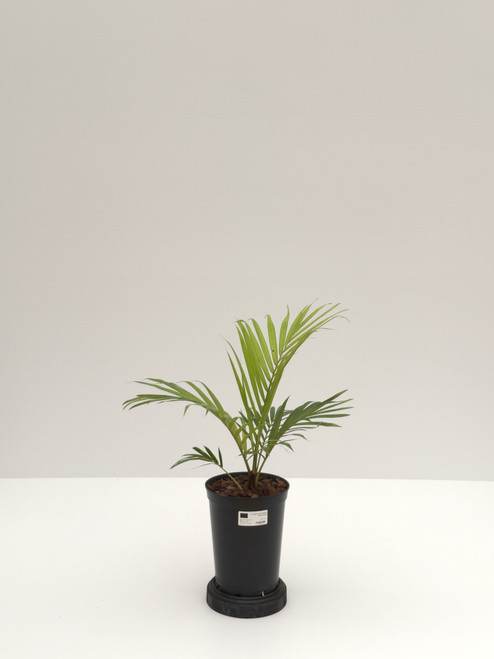Product Description
Habitat and Distribution
Madagascar. Only known from Maroantsetra and Mananara. Rain forest, steep slopes either near valley bottom or near ridge crest; 50-300 m.
Description
Solitary palm. TRUNK 6-15 m tall, 20-30 cm. in diam., near the crown 15-20 cm. in diam.; internodes 10-35 cm, pale to reddish-brown basally, grey-green distally, nodal scars 1-1.5 cm, pale brown; crownshaft well-developed, 1-1.2 m, about 25 cm. in diam., grey-green and covered in white wax except distally, where red-brown furry. LEAVES spirally inserted, occasionally tristichous, 6-7 in the crown, curved, with an untidy look, the pinnae held in all directions (plumose); sheath pale green to whitish, proximally waxy and glabrous, with distal dense soft pale reddish brown persistent tomentum, adaxially peach coloured; petiole 10-56 cm, 7 x 5.5 cm. in diam., channelled with sharp edges, with dense red-brown indument; rachis 3-3.5 m long, in mid-leaf 3.5 cm wide, with keel; pinnae 80-96 on each side of the rachis, grouped and fanned in 3s-6s, the group interval 3-7 cm, bent downwards at two-thirds of their length, the proximal 120-242 x 0.7- 2.4 cm, median 123-135 x 3.3-4 cm, distal 22-50 x 0.6-2 cm, connate for 1.5-4 cm, with a few large laciniate ramenta, without scattered scales. INFLORESCENCE infrafoliar, c. 0.5-1 x 0.5-1 m, branched to 2-3 orders; peduncle 18-26 cm. 7 x 3 cm. in diam.; prophyll 21-30 cm, borne at 3-4 cm above the base of the peduncle; peduncular bract deciduous, inserted at 9-11 cm from the base of the peduncle, 45-66 x 10-12 cm, not beaked or briefly beaked with triangular beak, split for 90%; non-tubular peduncular bract occasionally present on upper peduncle, to 20 cm; rachis 48 cm, with 14 branched and 10 unbranched first order branches; rachillae stiff or sub-pendulous, green to yellow-green, 16-40 cm long, 4-8 mm. in diam., glabrous, with dense flowers. STAMINATE FLOWERS only known in rather young bud, with sepals 2.1-3 x 2.5-2.8 mm, very hooded; petals < 1.5 mm; stamens 6, < 1.3 mm, probably versatile. PISTILLATE FLOWERS only known from the young fruit stage, with sepals 2.7-3.1 x 3-3.3 mm; petals 3.5-3.8 x 3-4 mm; staminodes 6, flat, tooth-shaped, 0.5 mm. FRUIT not known, except for the fibrous endocarp. SEED obovoid with pointed base, 9-10 x 7-8 mm, with homogeneous endosperm. EOPHYLL entire, deeply bifid. (J. Dransfield and H. Beentje. 1995)/Palmweb. Editing by edric.
Possibly closest to D. tokoravina, but with a totally different leaf sheath. (J. Dransfield and H. Beentje. 1995)/Palmweb.
Culture
Cold Hardiness Zone: 10a
Comments and Curiosities
An impressive tree; we found a second site only three months before the book went to press. The leaf-sheaths are distinct from any other, with their lower parts white-waxy and a golden-brown furry part at the very top. The name comes directly from the local name, which means stinking and refers to the smelly palm-heart. (J. Dransfield and H. Beentje. 1995)/Palmweb.
Conservation: Critical. Only known from two sites, both of which are under pressure from agriculture; populations consist of few individuals. (J. Dransfield and H. Beentje. 1995)/Palmweb.
Uses: Palm-heart smelly but still eaten; no other uses.












